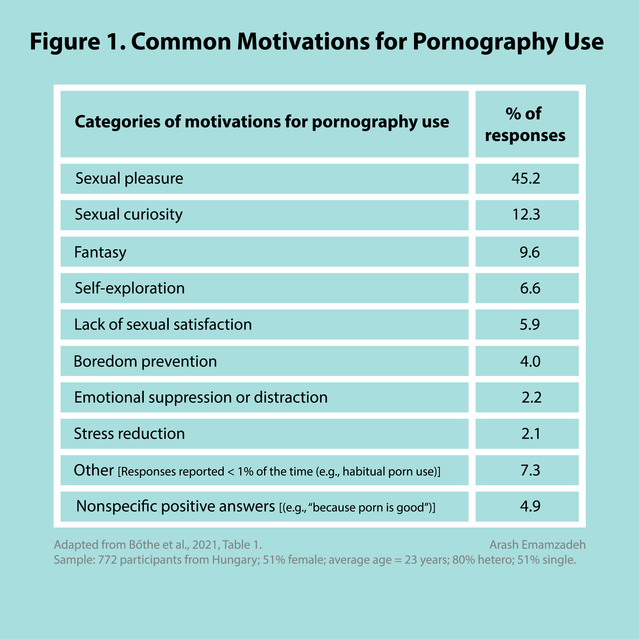Pornography
New Research: 8 Common Reasons People Use Porn
Understanding normal and problematic pornography use.
Posted May 9, 2021 Reviewed by Kaja Perina
Key points
- Sometimes porn viewing can become excessive or problematic (called problematic porn use or PPU).
- The frequency of porn viewing is associated with the following motivations: Stress reduction, sexual pleasure, and boredom avoidance.
- Problematic porn use is associated with these motives: Fantasy, pleasure, boredom avoidance, emotional distraction, and stress-reduction.

A recent article by Bothe and colleagues, published in the March issue of Psychology of Addictive Behaviors, examines the reasons people watch pornography; and the potential causes of problematic Internet pornography viewing (sometimes called problematic porn use, or simply porn addiction).
How the study was conducted
The investigators used three samples of participants from Hungary.
Sample 1: 772; 51% female; average age of 23 years (18-54 years range); 51% single and 47% in a romantic relationship (only 2% married); 80% heterosexual, 17% bisexual, 2% gay or asexual; using porn weekly.
Sample 2: 792; 6% female; average age of 40 years (19-76 years); 20% single and 35% in a romantic relationship (44% married); 80% heterosexual, 18% bisexual, 2% gay or asexual; 2-3 times weekly porn use.
Sample 3: 1,082; 50% female; average age of 24 years (18-64 years); 40% single and 54% in a romantic relationship (5% married); 82% heterosexual, 15% bisexual, 2% gay or asexual; weekly porn use.
The measures included a newly constructed scale called the Pornography Use Motivations Scale (PUMS), consisting of eight factors (examples in parentheses):
- Boredom avoidance (e.g., “I watch porn because I want to pass time when I am bored.”)
- Emotional distraction or suppression (“I watch porn to suppress my bad mood.”)
- Fantasy (“I watch porn because I can be a part of things that I cannot experience in real life.”)
- Lack of sexual satisfaction (“I watch porn because my sexual life is not satisfying.”)
- Self-exploration (“I watch porn to get to know my own sexual desires better.”)
- Sexual curiosity (“I watch porn to learn new things.”)
- Sexual pleasure (“I watch porn because it makes masturbation easier.”)
- Stress reduction (“I watch porn because it is one of the best ways to relieve stress.”)
A second scale, the Problematic Pornography Consumption Scale (PPCS), was used to evaluate problematic pornography use. It contained six factors:
- Conflict (“Watching porn prevented me from bringing out the best in me.”)
- Mood modification (“Watching porn got rid of my negative feelings.”)
- Relapse (“When I vowed not to watch porn anymore, I could only do it for a short period of time.”)
- Salience (“I continually planned when to watch porn.”)
- Tolerance (“I felt that I needed more and more porn in order to satisfy my needs.”)
- Withdrawal (“I became agitated when I was unable to watch porn.”)
The takeaway
Findings regarding motivations for porn use, frequency of pornography viewing, problematic porn use, and gender differences are summarized below.
Motivations
The top three motivations for porn viewing were sexual pleasure, sexual curiosity, and fantasy.
Frequency of pornography viewing
Sexual pleasure had a moderate relationship with the frequency of porn use, while boredom avoidance and stress reduction had a weak relationship with it. Sexual curiosity, fantasy, lack of sexual satisfaction, emotional distraction or suppression, and self-exploration had no association with the frequency of pornography viewing.
Problematic pornography use
Sexual pleasure, fantasy, boredom avoidance, and emotional distraction or suppression were weakly associated with problematic porn viewing, while stress reduction had a moderate association with it. Sexual curiosity, lack of sexual satisfaction, and self-exploration were unrelated to problematic porn use.
Men vs. Women
Compared to women, men had higher scores in the use of porn for sexual pleasure, emotional distraction or suppression, stress reduction, boredom avoidance, fantasy, and lack of sexual satisfaction. No gender differences were found in sexual curiosity and self-exploration motives.
Summary
In summary, the top motivations for porn use were sexual pleasure (45%), sexual curiosity (12%), and fantasy (10%). See Table 1.

More importantly, compared to other motives, emotional distraction/suppression and especially stress reduction had the strongest association with problematic porn use. Why? Perhaps because individuals with problematic porn viewing often use pornography to self-medicate and to manage their stress.
In a way, this makes sense because compared to established stress-management techniques, pornography viewing might appear to be a quicker and more convenient way of reducing stress. However, porn viewing can become excessive and inappropriate, itself becoming a source of stress and relationship conflict.
It is important to note that stress reduction may not by itself (i.e. without emotional distraction or emotional suppression motives) result in problematic porn use. In other words, problematic porn use is likely more common in people “who use pornography not only to reduce their stress but also to avoid negative feelings, forget about their problems, and escape from the real world.”
This suggests porn addiction may develop not just in people with certain personality traits (e.g., impulsive, compulsive), but individuals currently feeling overwhelmed, unable to cope or regulate their emotions successfully.
So, psychological interventions aimed at helping these individuals cope more effectively (e.g., using relaxation techniques, problem-solving strategies) might also prevent the development of problematic porn viewing habits.
Future studies are needed to examine the stability of motivations for watching pornography (and pornography addiction), and to investigate porn consumption motives in people from other cultures and countries.
Facebook image: Syda Productions/Shutterstock




